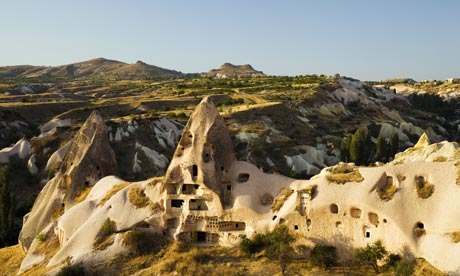
Staying in a cave hotel in Urgüp in Cappadocia, I found I was having dreams that were deeper and more subterranean than usual. All night I seemed to be excavating the past. These nocturnal experiences echoed the activities of the day when I visited the dwellings, churches and cathedrals dug into the walls of valleys and deep into the earth.
The inhabitants of this geographical centre of the Anatolian plain have carried out a good deal of excavation in the course of their long history. Unlike in Petra, Jordan, where the Nabateans dug facades in the soft sandstone with no obvious practical function, the inhabitants of Cappadocia dug their homes in the rocks as well as their churches, cathedrals and mosques. The most elaborate manifestation of this is in the Göreme Valley, at the centre of the region near a village of the same name. The houses of those who once lived here are half built of stone, half dug into the rock. Many have attractive double arched windows with large sills. For the inhabitants who have been relocated to turn this into an open-air museum, these must have provided superb sitting areas: cool and with good views. Now their only residents are the flies that buzzed incessantly. Outside it is still possible to see the remains of their gardens with iris, asparagus and apricot trees. But these are not what the tourists come to see. Rather it is the monasteries and churches with an occasional mosque that are located on an amphitheatre-like slope. The churches which show strong Egyptian and Syrian influence have descriptive local names such as Apple, Snake, Dark, Sandal and, in two cases, simply Nameless.
Leaving the valley, I drove some 30km south to the ancient underground city of Kaymakli. This storied city has been well preserved and adapted with good lighting and safety measures for the large numbers who flock to it. Entering the city is like going into a cistern. Only a small hole is visible on the ground. I was told that this was how the Christians survived. When the invaders came through the natural routes that cross Anatolia, meeting in Cappadocia, the Christians took their families and slipped down through this hole in the ground. Underneath were houses, churches, schools, shops: everything a community needs. They stayed until it was safe to emerge. Then they rolled back the stone and climbed out. I was told that pathways between a number of these different underground villages go for many miles under the earth.
But for those, like me, who worry about being trapped in closed spaces, there is a superb alternative, a walk in the Ihlara valley, a U-shaped canyon formed by the torrential waters flowing from the Hasan Dag volcano and the Melendiz mountains into the Salt Lake. The valley is 16km long. I started about midway, going down stairs at the end of which I was surprised to find an official sitting behind a desk who insisted that I buy a tezkara (ticket). I had not been aware that to take a walk in the valley one needed a ticket.
When I first started on this path, I was concerned that the high rock walls in which this canyon is trapped would make for a dull walk. I immediately changed my mind when I saw the tall birch and lime trees and heard the loud croaks of the frogs, the singing of the birds and the rich variety of wildflowers along the banks of the Melendiz stream that runs through the canyon. Along the path were plenty of large boulders that had fallen from the walls in this earthquake-vulnerable country, the presumed start of the Great Rift Valley that connects Palestine, where I live, with Turkey. All the countries along this section of the Rift, east of the Mediterranean, were ruled from Istanbul for 400 years, until 1918. Not only does this valley have great natural beauty, there are some 100 churches and monasteries carved in the rocks to be visited along the way. They show Egyptian, Syrian, and Turkish influences. The best preserved of these – such as Purenliseki, Karanlik and Kokar churches – have colourful frescos and crosses painted on the walls, some reflecting styles not encountered in Byzantine art.
Once back on the track I began thinking of the defaced faces of the monks in these frescoes. I was surprised at how disturbed it made me feel. Perhaps it was because the damage that was done was so persistent. Not a single one of these figures still had their eyes.
Near the end of my walk I stopped at a church dedicated to St George. The frescoes there date to the end of the 13th century. St George is seen between a man and a woman dressed typically in the Turkish style of their time. Soon after I could hear the voice of the muezzin from the mosque in the village of Belisirma. I knew that I had reached the end of this grand tour of the ancient churches and representations of a more tolerant way of life that had allowed more cultural and religious diversity than is now possible.
• The Serrin cave house has rooms from €120 per night.
Raja Shehadeh's new book, A Rift in Time: Travels of My Ottoman Uncle, will be published by Profile Books in August.

